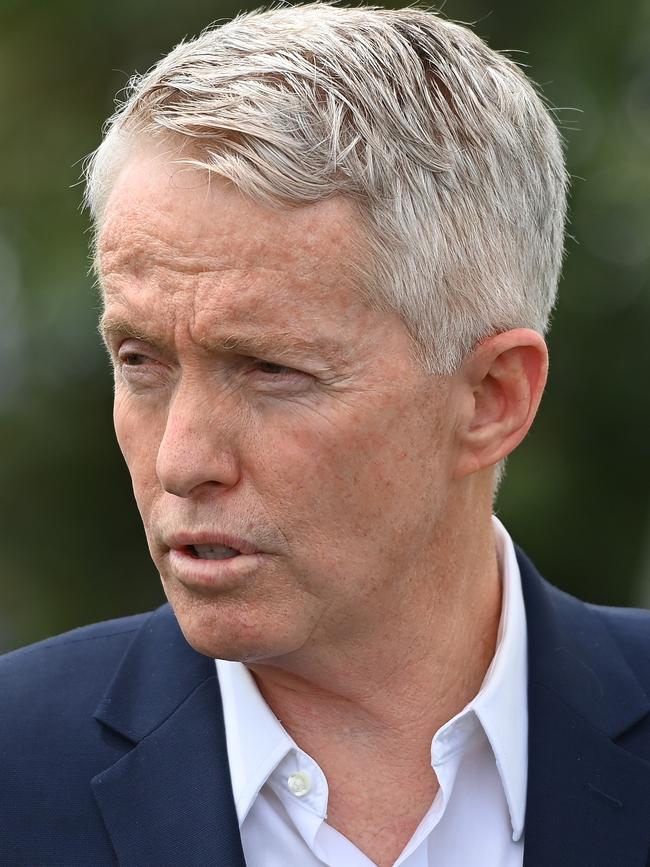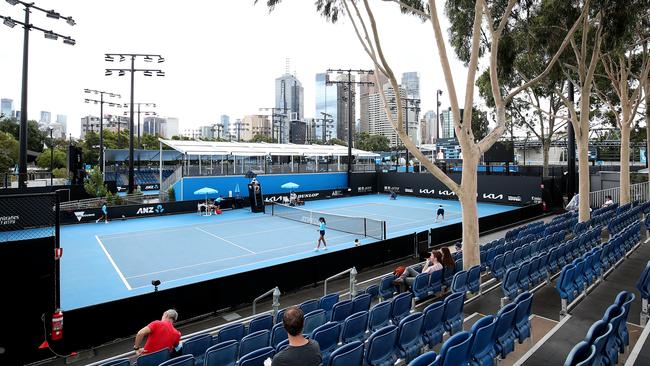Government overrules Aus Open plan to let fans go maskless
The state government has axed a decision by Australian Open organisers to let tennis fans sit under closed roofs without a mask.

Coronavirus
Don't miss out on the headlines from Coronavirus. Followed categories will be added to My News.
The state government has overruled an Australian Open decision to let fans be mask-free under the roof at the tennis.
Organisers had told the Saturday Herald Sun masks would not be needed by indoor seated spectators, despite all Victorians being forced to wear masks indoors.
But the state government late last night overturned the Australian Open decision, after being informed by the Saturday Herald Sun of the plan.
The confusing late change, just days before the Open starts, comes as authorities work to stamp out a Covid outbreak linked to an Australian Open hotel quarantine worker.
Australian Open chief Craig Tiley had earlier said seated fans could be mask-free when watching the Open, but would wear them at indoor bars and restaurants and when walking to and from their seats.
“When the roof closes and you’re sitting there, you don’t have to wear your mask,’’ he said.
Earlier Mr Tiley had outlined the Open’s mask plan, with the tournament to start on Monday.
“When you get up and you walk to the concourse, you put your mask on,” Mr Tiley said.
“But when you’re outside or you’re sitting in the stadium, even if the roof closes, you don’t have to put your mask on.’’


Last night a state government spokesman contacted the Saturday Herald Sun to say the Department of Health had been in touch with Tennis Australia to explain to them masks would have to be worn by fans when the roof is closed.
“Under the updated changes to the COVIDSafe Summer restrictions that came into effect as of 11.59pm 3 February 2021, masks are mandatory in indoor spaces,” the spokesman said.
“This includes stadiums and other event venues.
“In the context of the Australian Open, when the roof is closed at its venues with retractable roofs, these venues are deemed to be indoor spaces under the restrictions and masks use is required by all spectators and officials.”
Tennis players will be exempt for these restrictions because they are covered under the rules for indoor physical recreation.
Fans will still be able to watch the tennis without a mask in their seats when the roof is open.
Premier Daniel Andrews ordered all Victorians to wear a mask indoors on Wednesday night and the government’s coronavirus website on Friday night stated: “Face masks must be worn in indoor spaces apart from when eating or drinking”.
Opposition health spokeswoman Georgie Crozier slammed the original decision to allow fans to be mask-free and said the government was in chaos.
“This is what happens when you make rules for one set of people and different rules for the rest of Victorians,” she said.
“They’re under pressure, they got it wrong and Victorians just want consistency and to know they’re safe.
“The government is making these knee-jerk decisions and it creates uncertainty for everyone else.”
More than 500 Australian Open players, officials and support staff who were in quarantine at the Grand Hyatt and were considered casual contacts of the hotel worker who tested positive were on Friday released from isolation after all posting a negative test result.
This year’s Open will be split into three strict sections — fenced off, patrolled by security and only accessible with a ticket to that area.
The Rod Laver Arena Zone will admit a maximum of 12,500 fans with the Margaret Court Arena Zone restricted to up to about 10,000 and the John Cain Arena Zone allowed no more than 7500.
In an exclusive interview with the Saturday Herald Sun, Mr Tiley has also revealed coronavirus would likely hit the Australian Open next year as well, causing crowd number reductions, border issues, strict testing regimes and hotel quarantine requirements.
“I’m not planning for the possibility, I think more the probability,’’ Mr Tiley said.
“I think it’s going to happen.
“I think there will be a version of quarantine program for 2022.’’
Mr Tiley said this year’s major event was only possible because “Victoria and Melbourne really stepped up’’.

He said Melbourne Park presented “the best possible environment we can have’’ to stage a Covid-safe Open.
But he expected similar hurdles next year and hoped lead-up events could be staged interstate as well as Victoria.
“We’ve got to figure out what will be the best way to deliver it but likely it will be interstate, it will be in different cities leading in,’’ he said.
“We will have different quarantine programs in different cities and hopefully it is more resort based, where players can use it as a pre-season training.’’
Tennis Australia would push for players to arrive in Australia by December so they could complete up to two weeks of quarantine and be in Melbourne in time for the Open to resume its traditional January start time.
“It will depend on what the quarantine conditions are, isolation conditions and testing conditions and we will have to adjust back from whatever they are,’’ he said.
No more than 30,000 socially distanced fans will be allowed at the tennis on any one day this year and Mr Tiley was confident spectators would not be spooked by this week’s positive COVID-19 result.
“I think the community wants some certainty it is going to be safe and the site is going to be one of the safest places in Melbourne,’’ he said.
“People aren’t going to be on top of each other, its going to be physically distanced, we have a contact tracing system, the site is split into three separated zones … so we think it’s a great safe place to come and we hope that the community does so.’’




